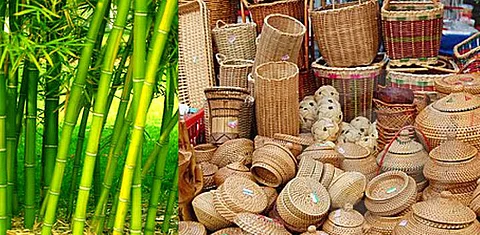
- Home
- Live Blog
- Breaking News
- Top Headlines
- Cities
- NE News
- Sentinel Media
- Sports
- Education
- Jobs

The National Bamboo Mission promotes bamboo cultivation, traditional bamboo products, and value addition in Assam and supports efforts by the state government to develop the bamboo value chain. While these initiatives have led to growth of bamboo-based industries and entrepreneurship to leverage traditional bamboo craftwork, the traditional Assamese bamboo growers are yet to notice the profitable business of bamboo poles, bamboo sticks and bamboo boards, when businessmen belonging to various other communities are making a roaring trade of these bamboo products. The trade of bamboo poles is quite simple – harvesting them and transporting them to primary marketing centres like Guwahati and various urban markets and selling those to prospecting buyers. Use of bamboo scaffolding in the real estate sector in the capital city and various urban growth centres has significantly risen. Apart from its use in slab casting, bamboo scaffolding is also preferred for painting, repair and maintenance of multi-storeyed residential, government and commercial buildings. Rising demand has also led traders to leverage online trading platforms to reach out to wider markets beyond the state. Apart from bamboo poles, these traders also deal in bamboo sticks, bamboo incense sticks, bamboo panels and laminated bamboo boards. Yet, the striking paradox of growing bamboo in the backyards, community agroforests and traditional cultural practices of Assamese and other indigenous communities and the negligible presence of indigenous traders in such bamboo trade paints a grim picture of the failure of indigenous communities to tap the commercial bamboo trade. The state government mandated the use of 5% bamboo-based materials in the construction of all public buildings by the Public Works Department to boost the local bamboo industry. The first biorefinery of the Northeast region, which is likely to be commissioned next month, will require a steady supply of five lakh tonnes of bamboo annually for sustainable and commercially viable production. This will not only require raising more bamboo plantations in the state but also processing the raw bamboo into chips of the required size and transporting them to the refinery at Numaligarh. How many Assamese youths are aware of this huge bamboo business opportunity? This is the pertinent question to be asked while reviewing the implementation of the state cane and bamboo policy to identify the gaps and make recommendations to close those. They must be able to look at the larger prospect of bamboo trade – aggregating it from growers, processing and supplying – and must not limit their dreams to becoming a mere daily wage earner at processing units making bamboo chips. Traditional bamboo craftwork has flourished in the state, with the bamboo mission facilitating product diversification. However, supplies of various craft items, both decorative and utility items – including household bamboo utensils sold in retail outlets along the National Highway stretches in Morigaon district, particularly for retail outlets owned by immigrant settlers – being sourced from manufacturing units in Barpeta speaks volumes about the decline in craftwork as a profession among local Assamese artisan families. The commercial aspect plays a crucial role in the survival of skill and expertise in bamboo craftworkamong traditional artisans’ families belonging to indigenous communities. If the decline is not checked, the commercial vacuum will gradually be filled up by immigrant settlers from the nearby areas, and the rich cultural tradition among indigenous communities becoming extinct is just a matter of time. Reversing the trend will require indigenous youth to realise the growing commercial potential of traditional craft items, and increasing it through product diversification can make them market leaders and create gainful employment opportunities for youth from their villages to take it as a profession. Some Assamese entrepreneurs scripting success stories of tapping markets outside the state and abroad with the adoption of creative design and value addition is an encouraging development. But losing the local markets of craft items will only make it more difficult for existing artisan families to pass on the heritage and the craft skill to their next generation when they are unable to see the commercial potential. The bamboo policy focusing on direct linkage between artisans and consumers is essential, but without business enterprise as a community, even handholding support by the government under the bamboo mission will not be able to address the larger problem of cultural preservation. Building the capacity of traditional bamboo artisans to cater to new market demands needs to be supplemented with building capacity among indigenous youth to tap every single opportunity of the bamboo business. Once they master the core trade of bamboo pole aggregation, transportation and retail sale, they will also be able to realise the potential of procuring bamboo machinery and tools to diversify their business. The primary focus of the state bamboo policy needs to be on inculcating a business mindset among traditional bamboo growers for transforming their traditional craft into a sustainable enterprise. Only then will bamboo grown in the backyards become the green gold for Assamese people in the true sense.